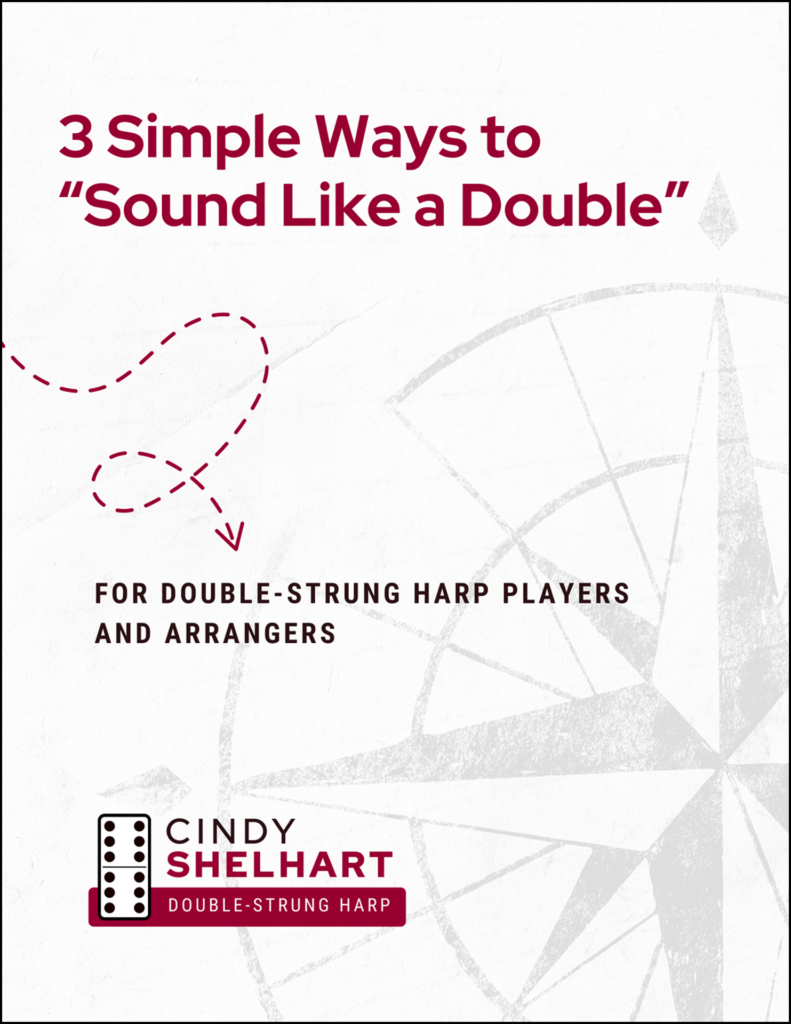Hi, I’m Cynthia Shelhart. You can call me Cindy. And it’s time for some #DoubleTalk. Double-strung harp, that is!
Welcome, or welcome back, to our channel featuring the modern double-strung harp and its music. If you’re new here, make sure you subscribe to my mailing list and YouTube channel, so you can be notified of future episodes (and catch up on the back catalog)!
This series, Know The Score, takes a behind-the-scenes look at arranging for double-strung harp, based on The Technique Triangle™️, my signature framework for double-strung harp technique.
Each episode shows how I use The Technique Triangle in different ways, in different arrangements, to help your double-strung harp “sound more like a double.”
About the Tune
Today’s Episode 2 arrangement is an adaptation of Jesu, Joy of Man’s Desiring, by Johann Sebastian Bach, who, in turn, arranged and orchestrated an earlier hymn tune by Johann Schop. Bach’s version appears in his 1723 cantata Herz und Mund und Tat und Leben, BWV 147.
This arrangement comes from my book Double the Weddings, part of The Double Dozen Series (available at CindyShelhart.com). You can play this arrangement not only for weddings, but also for recitals, concerts, special events, and worship services.
In this video, I’ll play the arrangement twice through, leaving out the optional repeat of measures 9 through 24.
About the Arrangement
Throughout the arrangement, the left hand accompaniment is varied with single notes as well as chords.
In measure 12, the left hand D major triad stays above middle C, so the stacked thirds of the triad don’t sound muddy (if they go too low).
This arrangement features Overlap Technique—what I like to call the double-strung harp’s “combo platter.” It brings everything together. Both hands can play independent parts, and it also features elements of Echo and Split Techniques. If you need a refresher on Overlap Technique, watch the “Know The Score” overview episode for a review of The Technique Triangle.
In measures 9 through 16, while the right hand plays the chorale theme with chords, the left hand switches to a single-note line that imitates the basso continuo of Bach’s original.
Using Overlap Technique
Overlap Technique isn’t just a convenient way to play the left hand up an octave. It’s also a way to make “less” sound like “more.” This comes from arranging with simpler textures that make room for the double-strung harp’s extra resonance, from its extra strings.
This doesn’t have to be boring—nor is it dumbing it down. It’s an INTENTIONAL way to use musical texture, in a way that works best for the double-strung harp AND for your arrangement.
So this arrangement of Bach’s Jesu, Joy Of Man’s Desiring is just one example of how you can use the “less is more” texture of Overlap Technique to show off the extra resonance, the extra strings of the double-strung harp.
For YOUR next arrangement, try a “less is more” Overlap Technique approach, with some ideas like:
- Using left hand patterns and chord voicings that use consonant intervals: unisons, fourths, fifths, and octaves.
- Varying the accompaniment pattern between chord tone patterns and single notes.
- And shifting between registers for contrast…you don’t need to use Overlap Technique all the time. You can move back and forth [in and out of Overlap] to vary your arrangement.
For more details on double-strung harp arranging with Overlap Technique, along with the other techniques of the Technique Triangle, watch for my upcoming double-strung harp arranging book!
Wrapping Up
Thanks for joining me today for Episode 2 of Know The Score. If you liked what you heard today, please make sure you’re subscribed, so you can be notified of future episodes. And if you want to be the first to get some more Double Talk, head on over to my website, CindyShelhart.com, and sign up for my mailing list.
Next time, in Episode 3, it’s a double feature. We’ll use Split Technique AND Overlap Technique to work some Mendelssohn magic with accidentals. Stay tuned (and subscribe) for more #DoubleStrungExcellence with Know The Score… see you next time!

